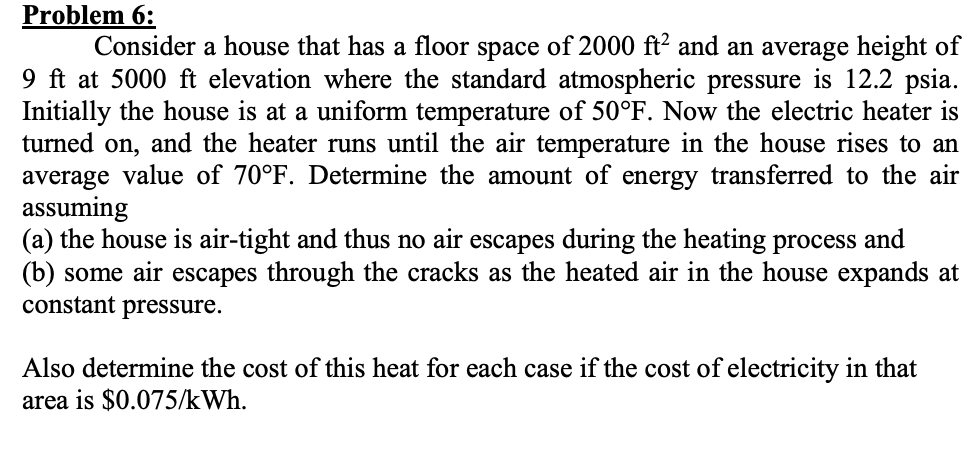Problem 6: Consider a house that has a floor space of 2000 ft² and an average height of 9 ft at 5000 ft elevation where the standard atmospheric pressure is 12.2 psia. Initially the house is at a uniform temperature of 50°F. Now the electric heater is turned on, and the heater runs until the air temperature in the house rises to an average value of 70°F. Determine the amount of energy transferred to the air assuming (a) the house is air-tight and thus no air escapes during the heating process and (b) some air escapes through the cracks as the heated air in the house expands at constant pressure.
Problem 6: Consider a house that has a floor space of 2000 ft² and an average height of 9 ft at 5000 ft elevation where the standard atmospheric pressure is 12.2 psia. Initially the house is at a uniform temperature of 50°F. Now the electric heater is turned on, and the heater runs until the air temperature in the house rises to an average value of 70°F. Determine the amount of energy transferred to the air assuming (a) the house is air-tight and thus no air escapes during the heating process and (b) some air escapes through the cracks as the heated air in the house expands at constant pressure.
Elements Of Electromagnetics
7th Edition
ISBN:9780190698614
Author:Sadiku, Matthew N. O.
Publisher:Sadiku, Matthew N. O.
ChapterMA: Math Assessment
Section: Chapter Questions
Problem 1.1MA
Related questions
Question
please explain the steps you took to get the answer please, Thank You

Transcribed Image Text:Problem 6:
Consider a house that has a floor space of 2000 ft² and an average height of
9 ft at 5000 ft elevation where the standard atmospheric pressure is 12.2 psia.
Initially the house is at a uniform temperature of 50°F. Now the electric heater is
turned on, and the heater runs until the air temperature in the house rises to an
average value of 70°F. Determine the amount of energy transferred to the air
assuming
(a) the house is air-tight and thus no air escapes during the heating process and
(b) some air escapes through the cracks as the heated air in the house expands at
constant pressure.
Also determine the cost of this heat for each case if the cost of electricity in that
area is $0.075/kWh.
Expert Solution
This question has been solved!
Explore an expertly crafted, step-by-step solution for a thorough understanding of key concepts.
This is a popular solution!
Trending now
This is a popular solution!
Step by step
Solved in 2 steps

Knowledge Booster
Learn more about
Need a deep-dive on the concept behind this application? Look no further. Learn more about this topic, mechanical-engineering and related others by exploring similar questions and additional content below.Recommended textbooks for you

Elements Of Electromagnetics
Mechanical Engineering
ISBN:
9780190698614
Author:
Sadiku, Matthew N. O.
Publisher:
Oxford University Press

Mechanics of Materials (10th Edition)
Mechanical Engineering
ISBN:
9780134319650
Author:
Russell C. Hibbeler
Publisher:
PEARSON

Thermodynamics: An Engineering Approach
Mechanical Engineering
ISBN:
9781259822674
Author:
Yunus A. Cengel Dr., Michael A. Boles
Publisher:
McGraw-Hill Education

Elements Of Electromagnetics
Mechanical Engineering
ISBN:
9780190698614
Author:
Sadiku, Matthew N. O.
Publisher:
Oxford University Press

Mechanics of Materials (10th Edition)
Mechanical Engineering
ISBN:
9780134319650
Author:
Russell C. Hibbeler
Publisher:
PEARSON

Thermodynamics: An Engineering Approach
Mechanical Engineering
ISBN:
9781259822674
Author:
Yunus A. Cengel Dr., Michael A. Boles
Publisher:
McGraw-Hill Education

Control Systems Engineering
Mechanical Engineering
ISBN:
9781118170519
Author:
Norman S. Nise
Publisher:
WILEY

Mechanics of Materials (MindTap Course List)
Mechanical Engineering
ISBN:
9781337093347
Author:
Barry J. Goodno, James M. Gere
Publisher:
Cengage Learning

Engineering Mechanics: Statics
Mechanical Engineering
ISBN:
9781118807330
Author:
James L. Meriam, L. G. Kraige, J. N. Bolton
Publisher:
WILEY